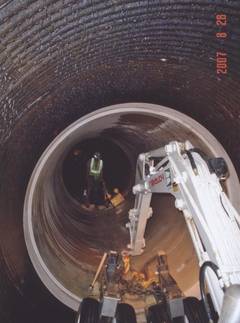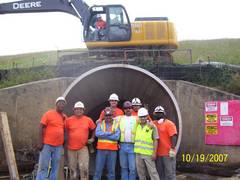Hydraulics, Structural Strength, Engineering Expertise, All Keys to a Successful Rehab
Bottom ash and fly ash are two main by-products of coal-fired electric utility generation. Bottom ash is a coarse, granular, incombustible material collected from the bottom of furnaces and conveyed to ponds or decant basins for dewatering, crushing and stockpiling for disposal or recycled use. Fly ash, a fine-grained powdery particulate captured from the flue gas during coal combustion, is often reused in portland cement or other construction and industrial applications, or stored in onsite ash ponds.
Site selection for the plant’s ash pond was a challenge because of the facility’s urban setting. Even in the mid-1960s, the area offered little undeveloped land on and around the plant site. As a result, one of the ash ponds was situated on a parcel bisected by a creek. The engineered solution was a 90-inch, 1630-foot long asphalt coated corrugated metal pipe (CMP) culvert installed to carry the stream and allow for the construction of the earthen embankment ash pond. The stream’s diversion culvert, which was installed along the original alignment of the creek, is buried beneath earthen dams and the ash pond and transitions along its length.
Through their regular inspection program, plant management identified the need to complete a detailed evaluation of the culvert to assess the need for rehabilitation. A local engineering consultant was hired to perform the assessment and design a solution. Along its length, the pipe had deflected up to 7.5 percent under the maximum vertical load, was locally corroded in several areas and had very loose soil backfill conditions present in several areas.
The engineering consultant with assistance from Hobas PIPE USA devised a plan to rehabilitate the line by sliplining the existing CMP with centrifugally cast fiberglass reinforced polymer mortar (CCFRPM) pipe. The liner pipe diameter was specified to maximize the final interior diameter of the rehabilitated line for greatest hydraulic capacity. This included consideration of the minimum radial clearance for fit and annular grouting.
“We were faced with many installation challenges including the condition of the existing CMP. Hobas supplied a flush joint pipe, which provided the most radial clearance to the existing pipe, as well as custom short sections to navigate the directional changes in the line. Since the original line was laid very near to an existing streambed, it followed the stream and was not straight, with 30 degree and nine degree horizontal elbows. Fortunately, we were provided a very accurate survey to work with to custom make the fittings,” said Dan Davis, Eastern Division Manager for Hobas PIPE USA.
Because they were buried at great depth beneath the embankment dams and ash stack, the two horizontal bends were inaccessible from above. The fittings had to be carried to the proper location through the line. Access to the outlet was limited due to the transition to two smaller box culverts at the buried outlet location under a rail crossing. As a result, the entire length of the 1630-foot line was rehabilitated by carrying segments into the existing culvert, piece by piece, building from the downstream side towards the inlet structure. The location of the first elbow, a 30-degree horizontal bend, is 100 feet upstream of the outlet, meaning the lower 100 feet of line was accessible only after negotiating both bends. For this section, due to the reduced hydraulic cross-section required near the outlet, relatively short 6.5 foot long pieces of smaller diameter were utilized to navigate the bend. The middle portion of the line utilized longer sections of pipe since the nine degree elbow was much more navigable than the 30-degree bend.
“Our field service department made several trips to the plant for installation support both during the installation of the pipe and during the grouting process. There was extensive communication about the means and methods related to the pipe installation procedures, blocking diagrams, grouting calculations and the logistics in general,” stated Randy Whiddon, Field Service Manager, Hobas PIPE USA.
Hobas pipe was supplied in 72-inch, 78-inch and 84-inch diameter sizes for sliplining within the 90-inch existing CMP. In addition to the custom fittings manufactured by Hobas to accommodate the vertical deflections and diameter transitions within the line, a custom intake structure was built. The intake structure consisted of extending the existing headwall by concrete encasing a 110-inch by 84-inch Hobas eccentric reducer to provide increased hydraulic inlet efficiency. A 72-psi pipe stiffness product was utilized for the majority of the line to withstand the large hydrostatic forces and ash and embankment overburdens.
“One of the many benefits of using Hobas CCFRPM on slipline and tunnel applications is the flush joint configuration and the high strength composite. The tight fit allowed by the flush joint, the oversized inside diameter and the superior hydraulics allow for optimum flow recovery. This project required a pipe that could support the load from the future overburden and hydrostatic pressure. Corrosion resistance was also of utmost importance. Hobas CCFRPM pipe was able to meet all of the demanding project requirements,” Whiddon added.



